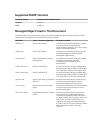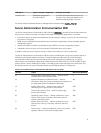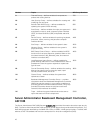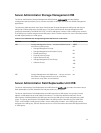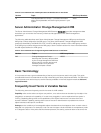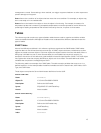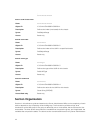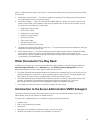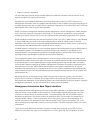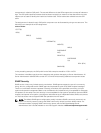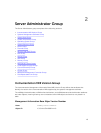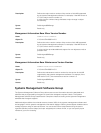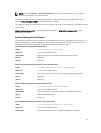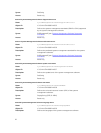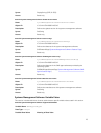• Index or indexes, if applicable
For each MIB group that has unique variable definitions, tables are included in the last section of the
section to explain the meaning of the terms.
Standards for writing MIBs are defined by the Internet Engineering Task Force (IETF). Structure of
Management Information (SMI) is a standard that specifies the rules for defining the structure and type of
managed objects and events in a MIB. SMIv1 is specified in Request For Comments (RFC) 1155. The Server
Administrator MIB conforms to the SMIv1 standard.
SNMP is a systems management standard originally designed for network management. SNMP manages
much more than networks. Information Technology (IT) professionals use SNMP for monitoring and
managing computer systems and the various components and peripherals supported by their systems.
SNMP standards are defined by the Internet Engineering Task Force (IETF). SNMP version 1 was published
in August 1988 and is the most commonly supported version of SNMP. SNMP version 2 was first
published in May 1993, but has not gained widespread market acceptance. SNMP version 3 was recently
completed and has addressed security issues that exist in version 1.
All SNMP systems consist of one or more managed systems that provide data through an SNMP agent to
a management system. The management system provides a user interface to view data from the
managed systems. The management system and managed systems communicate over a network
(typically through User Datagram Protocol/Internet Protocol [UDP/IP]).
The management system and a managed system communicate by means of a common data schema.
SNMP MIB files define the structure, type, and values of the SNMP data. While MIBs can be standardized
or enterprise specific, most operating systems supply SNMP agents for the standard MIB-I and MIB-II
schemas. MIB-I defines a base set of standard management information for systems implementing the
Internet Protocol (IP) suite. MIB-II defines characteristics of the system, characteristics of network
interfaces, and characteristics of components of the IP on the system. In addition to the standard MIBs,
many hardware vendors have defined MIBs that provide management data specific to their systems and
peripheral devices.
Monitored data can be retrieved through SNMP using the Get command. Typically, this command
requires the host name or IP address of the target machine as well as the OID of the data to retrieve.
Exact details are dependent on the operating system and the development tools being used to create the
management application. The Get command has a variant known as GetNext.
Management Information Base Object Identifiers
Each data class within a Management Information Base (MIB) is defined by an Object Identifier (OID).
OIDs are unique across all MIBs. An OID consists of a series of digits separated by periods. The OID
functions in a similar fashion to a phone number. The phone number 011-512-471-0000 uniquely
identifies a single phone. The phone number can be broken down into a number of components to
uniquely identify a phone. The first component, 011, is the country code for the United States. The
second component, 512, identifies the area code for central Texas. The third component, 471, is the
phone exchange for a large state university in the city of Austin. The final component, 0000, is the main
switchboard.
There are two main differences between the phone number example and an actual OID. The first
difference is that there are many more components in an OID, up to 128. The combination of these
16



